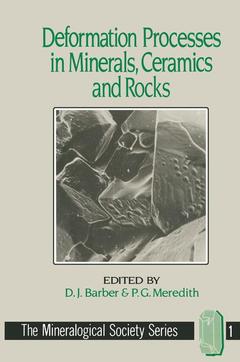Deformation Processes in Minerals, Ceramics and Rocks, Softcover reprint of the original 1st ed. 1990 The Mineralogical Society Series, Vol. 1
Langue : Anglais
Auteurs : Barber D.J., Meredith P.G.

This monograph has its origins in a two-day meeting with the same title held in London, England in the spring of 1987. The idea for the meeting came from members of the UK Mineral and Rock Physics Group. It was held under the auspices of, and made possible by the generous support of, the Mineralogical Society of Great Britain and Ireland. Additional financial assistance was provided by ECC International pIc and the Cookson Group pIc. The aims of the London meeting were to survey the current state of knowledge about deformation processes in non-metallic materials and to bring together both experts and less experienced Earth scientists and ceramicists who normally had little contact but shared common interests in deformation mechanisms. This monograph has similar aims and, indeed, most of its authors were keynote speakers at the meeting. Consequently, most of the contributions contain a review element in addition to the presentation and discussion of new results. In adopting this format, the editors hope that the monograph will provide a valuable state-of-the-art sourcebook, both to active researchers and also to graduate students just starting in the relevant fields.
An introduction.- References.- 1 Fracture and failure of brittle polycrystals: an overview.- 1.1 Introduction.- 1.2 Linear elastic fracture mechanics (LEFM).- 1.3 Quasi-static fracture and failure.- 1.4 Inelastic fracture processes.- 1.5 Fracture and failure prediction.- 1.6 Indirect monitoring of fracture.- 1.7 Concluding remarks.- Acknowledgements.- References.- 2 Single-crack behaviour and crack statistics.- 2.1 Introduction.- 2.2 Single-crack behaviour.- 2.3 Multiple-crack behaviour.- 2.4 Crack statistics: percolation models.- 2.5 Conclusions.- References.- 3 Fracture of polycrystalline ceramics.- 3.1 Introduction.- 3.2 Flaw size/grain size effects.- 3.3 Toughening mechanisms.- 3.4 Environmental effects.- 3.5 Implications of crack-interface tractions on failure predictions.- 3.6 Concluding remarks.- References.- 4 Compressive brittle fracture and the construction of multiaxial failure maps.- 4.1 Introduction.- 4.2 The isolated crack in an infinite plate.- 4.3 Crack interaction.- 4.4 Multi-axial failure maps.- 4.5 Summary and conclusions.- Acknowledgements.- References.- 5 Brittle-to-ductile transitions in polycrystalline non-metallic materials.- 5.1 Introduction.- 5.2 Effect of temperature (T) and strain rate ($${\dot \varepsilon }$$) on plastic flow and brittle cleavage.- 5.3 Effect of tension, compression, and confining pressure (stress triaxiality) on plastic flow and brittle cleavage.- 5.4 Transition from fracture to plastic flow.- 5.5 Discussion and conclusions.- References.- 6 Régimes of plastic deformation — processes and microstructures: an overview.- 6.1 Introduction.- 6.2 The phenomenology of creep.- 6.3 Creep mechanisms.- 6.4 The classification of deformation régimes and mechanical properties.- 6.5 The structure of grain boundaries and interfacesbetween phases, and the nature of intergranular films.- 6.6 Microstructures, preferred orientation, and models of crystalline plasticity.- 6.7 Concluding remarks.- Acknowledgements.- References.- 7 Experimental deformation and data processing.- 7.1 Introduction.- 7.2 The traditional methods.- 7.3 A global inversion method.- 7.4 An example of creep data processing.- 7.5 Conclusion.- Acknowledgements.- References.- 8 Experimental studies of deformation mechanisms and microstructure in quartzo-feldspathic rocks.- 8.1 Introduction.- 8.2 Experimental techniques.- 8.3 Experimental deformation of quartz aggregates.- 8.4 Experimental deformation of feldspar aggregates.- 8.5 Experimental deformation of quartzo-feldspathic aggregates.- 8.6 Summary.- Acknowledgements.- References.- 9 Microstructural analysis and tectonic evolution in thrust systems: examples from the Assynt region of the Moine Thrust Zone, north-west Scotland.- 9.1 Introduction.- 9.2 Deformation histories in thrust systems.- 9.3 The Moine Thrust Zone of north-west Scotland.- 9.4 The Moine Thrust at the Stack of Glencoul.- 9.5 The Assynt Thrust sheet.- 9.6 The Sole Thrust System.- 9.7 Discussion.- 9.8 Conclusions.- Acknowledgements.- References.- 10 Mechanisms of reaction-enhanced deformability in minerals and rocks.- 10.1 Introduction.- 10.2 Experimental data.- 10.3 Field and petrographic data.- 10.4 Deformation mechanisms.- 10.5 Conclusions.- Acknowledgements.- References.- 11 Thermodynamics of rock deformation by pressure solution.- 11.1 Introduction.- 11.2 Microscale continuum theory of constituent behaviour.- 11.3 Thermodynamic framework for a macroscale theory of aggregate behaviour.- 11.4 Intergranular pressure solution as a stationary non-equilibrium process.- 11.5 Concluding summary.- Acknowledgements.- References.- 12 Densification of crystalline aggregates by fluid-phase diffusional creep.- 12.1 Introduction.- 12.2 The model.- 12.3 Experiments on sodium chloride.- 12.4 Discussion.- 12.5 Summary.- Acknowledgements.- References.- 13 Dynamic recrystallization and grain size.- 13.1 Introduction.- 13.2 Dynamic recrystallization by migration: mechanisms and models.- 13.3 Microstructural measurements as a function of stress.- References.- 14 Simulation of dislocation-assisted plastic deformation in olivine polycrystals.- 14.1 Introduction.- 14.2 Slip systems.- 14.3 Texture predictions from Taylor theory.- 14.4 Texture predictions from self-consistent theory.- 14.5 Discussion.- Acknowledgements.- References.- 15 On the slip systems in uranium dioxide.- 15.1 Introduction.- 15.2 Effects of non-stoichiometry on microhardness, flow stress, and preferred slip system.- 15.3 The structure of half-slipped dislocations.- 15.4 Questions for future work.- Acknowledgement.- References.- 16 A TEM study of dislocation reactions in experimentally deformed chalcopyrite single crystals.- 16.1 Introduction.- 16.2 Dislocation reactions in crystals strained at 200°C.- 16.3 Dislocation reactions in crystals strained at 400°C.- 16.4 Discussion.- 16.5 Summary and conclusions.- Acknowledgements.- References.
Date de parution : 03-2012
Ouvrage de 424 p.
15.5x23.5 cm
Mots-clés :
© 2024 LAVOISIER S.A.S.



